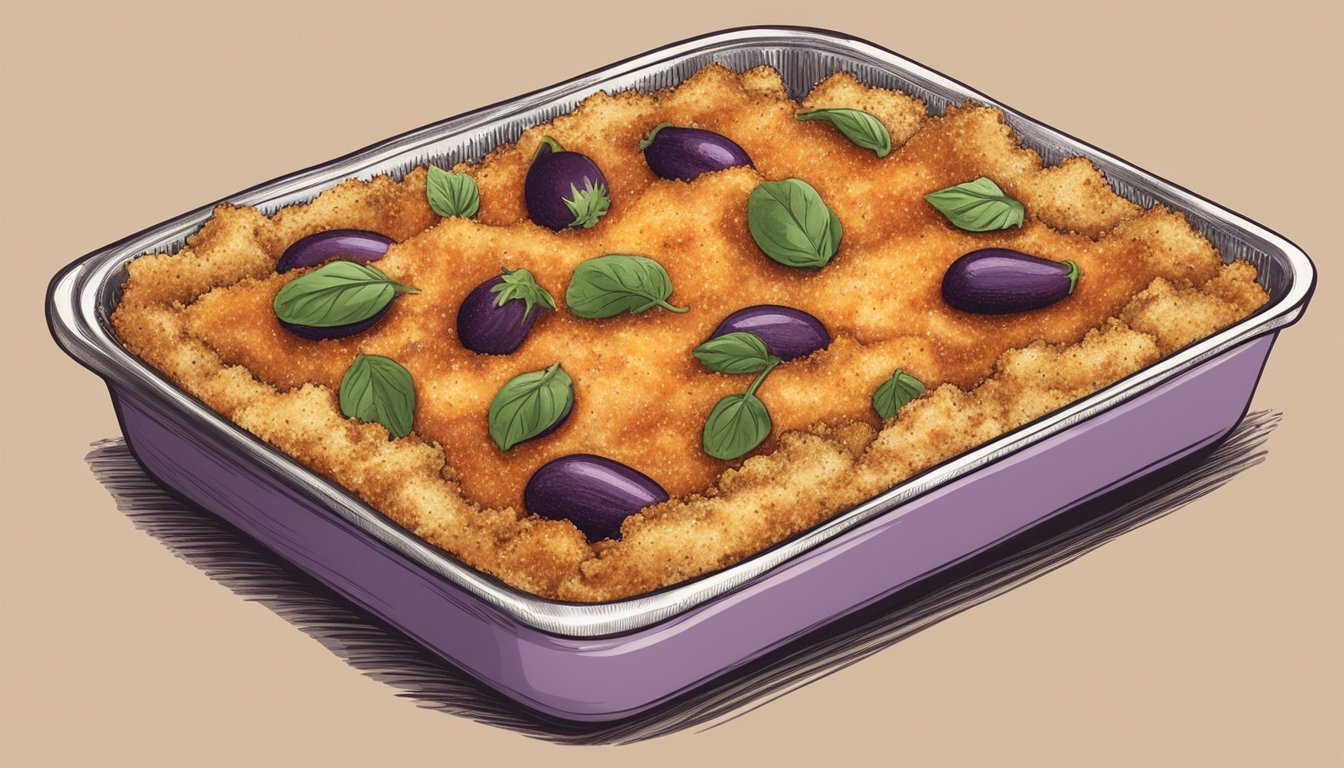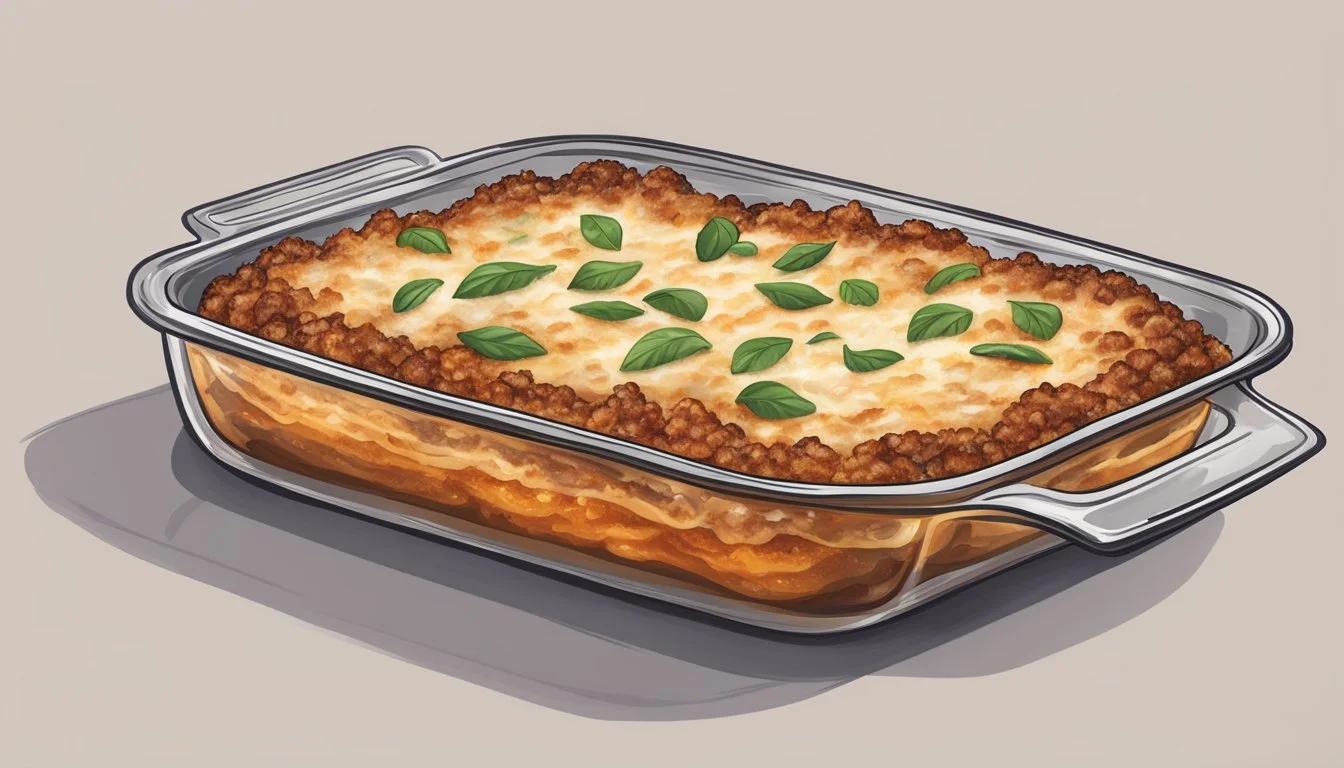Best Way to Reheat Eggplant Parmesan
Crispy Breading, Melted Cheese Secrets Revealed
Reheating eggplant parmesan (What wine goes well with eggplant parmesan?) while preserving its delectable crispy breading and sumptuous melted cheese can be a bit of a culinary challenge. The goal is not only to warm the dish but also to maintain its original texture and flavor that make it such a cherished meal. It requires a technique that carefully balances temperature and cooking time to ensure that the breading doesn't become soggy and the cheese emerges perfectly gooey.
One of the most effective methods to reheat eggplant (What wine goes well with eggplant?) parmesan employs the use of a conventional oven. Slow and steady warming in an oven preheated to a moderate temperature allows the heat to penetrate the dish thoroughly without compromising its crispy exterior. Covering the dish with foil can help retain moisture in the cheese and eggplant layers, preventing them from drying out.
Depending on the size and thickness of the eggplant parmesan slices, they can also be refreshed in a skillet with a bit of oil. This method is particularly good for keeping the breading crisp, as the direct heat from the pan crisps the exterior while the interior becomes hot. Care must be taken to prevent the cheese from burning or the breading from blackening, which can occur if left unattended or at too high a heat. With any reheating technique, patience is key to ensuring that the eggplant parmesan regains its ideal temperature without losing the qualities that make it a favorite dish.
Understanding Reheating Basics
Reheating eggplant parmesan efficiently requires attention to food safety, texture retention, flavor preservation, and an understanding of different reheating methods to achieve a dish that is as close to freshly cooked as possible.
Food Safety Considerations
Properly reheating food is crucial to avoid bacterial growth. It's important to ensure that eggplant parmesan reaches an internal temperature of at least 165°F (74°C). Using a temperature checker can confirm that the food is heated through to a safe level.
Keeping the Texture Intact
When reheating eggplant parmesan, maintaining the crispy texture of the breading without incurring moisture loss is a challenge. The key is to apply gentle heat and to cover the dish loosely to trap some moisture, but not so much that it steams the breading.
Flavor Preservation
To keep the flavors vibrant, avoid overheating which can dull the taste of spices and basil leaves. Gentle reheating can help preserve the intricate flavors of the dish and prevent the spices from becoming too muted.
Reheating Methods Overview
There are several methods to reheat eggplant parmesan, each with its benefits:
Oven: Preheat to 350°F (175°C) and bake covered with foil. Finish uncovered for a crispy top layer.
Microwave: Short bursts at a medium power setting with the food covered to distribute heat evenly.
Air Fryer: Can quickly reheat and crisp the breaded exterior but may unevenly heat the middle.
Stove: Gently heat in a skillet, adding a bit of oil to aid texture preservation.
Toaster Oven: Similar to oven but on a smaller scale, ideal for single servings.
Preparing Eggplant Parmesan for Reheating
Proper preparation of leftover eggplant parmesan ensures it maintains its texture and flavor during reheating. Ensuring the dish reaches room temperature before reheating and preparing your oven and container correctly are key steps.
From Fridge to Oven
One should start by removing the leftovers from the fridge and allow them to sit at room temperature for about 20-30 minutes. This step reduces the temperature gradient between the cold eggplant parmesan and the preheated oven, promoting even heating. While waiting, one can preheat the oven to 350°F. It's essential to use an oven-safe dish for reheating and to consider covering it with aluminum foil. The foil prevents the cheese from burning and the breading from drying out too quickly during the reheating process.
Procedure:
Let the eggplant parmesan sit out of the fridge for 20-30 minutes.
Preheat the oven to 350°F (175°C).
Transfer to an oven-safe dish if it's not in one already.
Optionally, cover with aluminum foil for moisture retention.
Sectioning for Even Reheat
For an even reheat, it's often beneficial to divide the eggplant parmesan into individual portions. This allows the heat to distribute more evenly, resulting in a uniformly warmed dish. The portions should be spaced apart slightly on a baking sheet lined with parchment paper, which can prevent sticking and help crisp up the breading. If the leftovers were stored in an airtight container, transfer the individual servings carefully to the prepared dish.
Steps:
Cut the eggplant parmesan into individual servings.
Space the pieces out evenly on a baking sheet.
Line the baking sheet with parchment paper for non-stick properties.
Oven Reheating Method
Reheating eggplant parmesan in the oven is ideal for maintaining a crispy coating while ensuring the cheese is perfectly melted. This section provides a detailed guide on using the oven method effectively.
Step-By-Step Oven Guide
Preheat the oven to 350°F (175°C).
Place the eggplant parmesan on a baking sheet or oven-safe dish.
Proceed to the next steps to optimize reheating.
Using Foil to Retain Moisture
Cover the dish loosely with aluminum foil to retain moisture.
Bake for 10-15 minutes before removing foil to allow the breading to become crispy.
Adding Extra Sauce
If the eggplant parmesan seems dry, add a spoonful of extra tomato sauce before covering with foil.
This helps to keep the dish moist and flavorful during reheating.
Utilizing the Broiler
After the initial baking time, remove the foil.
Switch to the broiler for 1-2 minutes to achieve a golden-brown, crispy exterior.
Watch carefully to prevent burning.
Post-Reheating Tips
Check the internal temperature to ensure it has been heated thoroughly.
Let it rest for a few moments after reheating to stabilize the heat distribution.
Serving Suggestions
Garnish with fresh basil leaves, grated parmesan, or black olives.
Serve with sides like garlic bread, steamed asparagus, or a crisp green salad for a complete meal.
Alternative Reheating Methods
When reheating eggplant parmesan, retaining the crispy texture of the breading and the meltiness of the cheese is paramount. Different methods can be used to achieve this goal, each with its specific instructions to preserve the dish's flavor and moisture.
Microwave Method
Using a microwave can be quick, but it often leads to a softer breading. To mitigate this, one can place the eggplant parmesan in a microwavable container, cover with a lid leaving it slightly ajar, and heat in short intervals, checking periodically to ensure even warmth without making the dish soggy.
Stovetop Skillet Method
For a crispier texture, the stovetop skillet method is effective. Preheat a tablespoon of olive oil in a skillet over medium-high heat. Add the eggplant slices in a single layer and cook for 1-2 minutes on each side until they reclaim their golden, crispy exterior.
Using a Toaster Oven
A toaster oven can recreate the oven's even cooking in a more compact space. Preheat the toaster oven to 325 °F (160 °C), place the eggplant parmesan in an oven-safe dish, covering loosely with foil to retain moisture. Warm for 5-10 minutes, then remove the foil and continue to heat for an additional few minutes to crisp the top.
Exploring the Air Fryer Option
An air fryer is an alternative that provides a crispy result without using excess oil. Preheat the air fryer to 350 °F (175 °C), arrange the eggplant parmesan in a single layer in the basket, and reheat for 5-8 minutes. Halfway through, check the dish to ensure it's reheating evenly and adjust if necessary.
Pro Tips for Best Results
Achieving the perfect consistency and flavor while reheating eggplant parmesan requires attention to detail. These tips aim to ensure that the breading stays crispy, the cheese melts beautifully, and the flavors are enhanced without common reheating errors.
Ensuring Crispy Breading
To maintain a crispy coating:
Preheat the oven to 350°F.
Use parchment paper on the baking sheet to prevent sticking and to help crisp the breading.
Cover loosely with foil to retain moisture without making the breading soggy.
Remove the foil for the final few minutes to allow the breading to crisp.
Cheese Melting Mastery
For perfectly melted cheese:
Avoid using the microwave, as it can result in unevenly melted cheese.
Sprinkle additional cheese on top before the final few minutes of reheating if desired.
Ensure that the internal temperature reaches 165°F to confirm that it's heated through and the cheese has melted.
Spice and Flavor Enhancements
To enhance flavor:
Add fresh spices or herbs like basil after reheating for a burst of flavor.
If the original recipe includes ricotta or cottage cheese, consider adding a fresh dollop to revive the creamy texture.
Avoiding Common Mistakes
Prevent common issues by:
Avoiding high temperatures which can dry out the eggplant and make the cheese rubbery.
Checking the internal temperature to prevent overheating and moisture loss.
Heating in increments and checking regularly to prevent overcooking.
By following these guidelines, one can ensure their reheated eggplant parmesan is as close to the freshly made dish as possible.
Storage and Preservation
Proper storage is crucial for maintaining the flavor and texture of eggplant parmesan while ensuring food safety. By following these guidelines, one can store leftover eggplant parm optimally and maintain its quality for a satisfying reheated meal.
Storing Leftover Eggplant Parmesan
To preserve the quality of leftover eggplant parmesan, it should be stored in an airtight container to prevent moisture loss and absorption of other flavors from the refrigerator. The dish should be allowed to cool down before placing it in the container to refrigerate; however, it should not sit out at room temperature for more than two hours to minimize the risk of bacterial growth. The ideal storage temperature in the refrigerator should be at or below 40°F (4°C). Properly stored, eggplant parmesan can be kept in the refrigerator for up to 3-5 days.
Freezing and Thawing Tips
For longer storage, one may freeze eggplant parmesan. To do so, wrap individual portions tightly with plastic wrap or aluminum foil and then place them in a freezer-safe airtight container or heavy-duty freezer bags. This not only prevents freezer burn but allows for easier portion control upon thawing. When ready to enjoy, it's preferable to thaw the dish in the refrigerator overnight for optimal texture retention. However, it is possible to reheat directly from the freezer, which may require additional cooking time.
Reheating After Freezing
Reheating eggplant parmesan after freezing is best done in the oven. Preheat the oven to 350°F (175°C). If the dish is still frozen, one might need to extend the usual reheating time by a few minutes to ensure the food is heated thoroughly to an internal temperature of 165°F (74°C), which is considered safe by food safety standards. As sauce can separate and become watery after freezing, covering the dish with foil during the initial phase of reheating helps retain moisture without making the breading soggy. Removing the foil during the last few minutes of heating will allow the cheese to melt perfectly and the breading to crisp up.
Healthy Accompaniments
When enhancing the already flavor-packed eggplant parmesan, one should consider healthy sides that complement the dish's creamy texture and rich taste. These additions should enhance the meal while maintaining a balance between indulgence and nutrition.
Vegetable Pairings
A vibrant green salad serves as a refreshing counterpart to the hearty eggplant parmesan. It introduces a crisp texture and lightness. Using a variety of greens like arugula, spinach, and romaine lettuce ensures a blend of flavors and nutrients. Adding steamed asparagus or broccoli florets, which can be simply seasoned with olive oil, salt, and pepper, can provide a satisfying crunch and earthy notes that balance the heaviness of the main dish.
Green Salad: Mixed greens, cherry tomatoes, cucumbers
Steamed Vegetables: Asparagus with a squeeze of lemon; Broccoli with a sprinkle of crushed red pepper
Complementing with Bread
Garlic bread made with whole grain adds a heart-healthy element to the meal. It's an excellent vehicle for soaking up rich tomato sauce while providing a satisfying chewy texture. Brushing the bread with a mix of olive oil, crushed garlic, and a bit of parmesan before toasting ensures each bite is flavorful.
Garlic Bread: Whole grain bread, olive oil, fresh garlic, parmesan
Additional Toppings and Sides
A sprinkle of basil leaves provides a bright and herby freshness that cuts through the richness, not to mention a pop of color. Incorporating black olives can give a salty bite that contrasts nicely with the sweetness of the tomato sauce. For those desiring an extra layer of flavor, a small serving of ricotta or freshly grated parmesan cheese can elevate the dish without overshadowing the eggplant parmesan itself. Lastly, a few slices of lean salami can introduce a savory, slightly smoky flavor that complements the main without adding unnecessary fats.
Cheese: Dollops of ricotta; a dusting of parmesan
Herbs: Chopped basil leaves for garnish
Olives and Meats: Sliced black olives; thin strips of salami
Conclusion
Reheating eggplant parmesan while preserving its distinctive crunchy breading and melting the cheese perfectly is achievable with the right technique. The oven method stands out as the best approach, delivering even heating and restoring the dish's original texture and flavor. Optimal results dictate preheating the oven to 350°F and covering the dish loosely with foil to prevent excessive browning.
In Oven:
Preheat to 350°F.
Place in an oven-safe dish.
Cover with foil; bake for 10 minutes.
Remove foil; bake for 5-10 additional minutes.
For those in a hurry or with smaller portions, a microwave can suffice, although it may slightly soften the breading. A skillet can offer a quick fix for crispness if one is careful not to overheat and dry out the eggplant.
Reheating eggplant parmesan can result in a dish that rivals its initial serve, particularly if a little extra cheese and sauce are added before the final bake. Once reheated, it pairs well with fresh pasta, a crisp salad, or crusty bread, transforming leftovers into a delightful meal with minimal effort.
Serving Suggestions:
Pair with pasta, salad, or bread.
Add cheese and sauce to freshen up.
In summary, reheating eggplant parmesan successfully calls for careful temperature control and timing. Whether using an oven, microwave, or skillet, patience ensures that the leftovers provide an enjoyable meal that closely mirrors the original experience.
FAQs
When reheating eggplant parmesan, the goal is to maintain the dish’s delicious crispiness and gooey cheese. Here, common questions are answered with clear instructions to achieve the best results.
Reheating Multiple Servings
To reheat multiple servings of eggplant parmesan while keeping the breading crispy, one should use the oven method. Preheat the oven to 350°F (175°C) and cover the eggplant parmesan with aluminum foil to prevent the cheese from burning. Heat the servings together on a baking sheet lined with parchment paper for even heat distribution.
Avoiding Sogginess
To avoid sogginess and retain the crispy texture, one should not use the microwave. Instead, their individual servings should be placed on a wire rack set over a baking sheet and reheated in a preheated oven. This allows air to circulate around the eggplant, which helps to keep the coating crisp. One can also add fresh grated cheese on top before broiling for the last few minutes to achieve a crispy, golden topping.
Optimal Internal Temperature
A temperature checker can be used to ensure food safety and the best quality of leftovers. The internal temperature of the eggplant parmesan should reach 165°F (74°C) before consumption. Checking the temperature ensures the dish is heated thoroughly without overcooking.
Keeping Toppings Crispy
To keep the toppings and crispy coating intact, reheat the eggplant parmesan uncovered in the oven for the final minutes. One can also use the broiler setting briefly to crisp up the surface. Watch closely to prevent burning. Additionally, adding a bit of freshly grated cheese during this step can enhance the crispiness and flavor.






